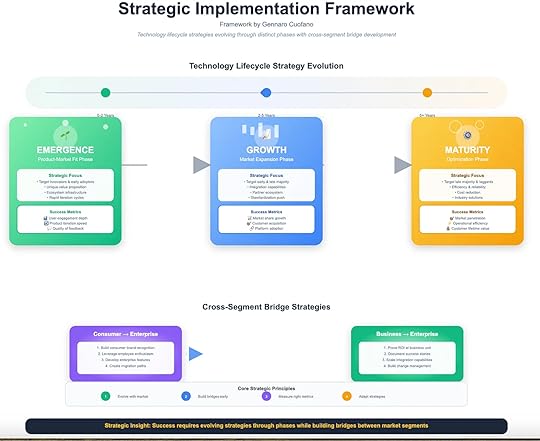Strategic Implementation Framework

Framework by Gennaro Cuofano, The Business Engineer
Technology adoption is not just about capability. It is about translating breakthroughs into scalable market value across time. The challenge: strategies that work in early phases become obsolete as adoption scales. Without strategic evolution, even the most powerful technologies stall.
The Strategic Implementation Framework maps adoption into three lifecycle phases—Emergence, Growth, and Maturity—while highlighting the cross-segment bridges that allow smooth progression from consumers to enterprises.
1. Emergence Phase (0–2 Years)Focus: Product–Market Fit.
This is the experimental stage. Technologies are raw, ecosystems are immature, and adoption is concentrated among innovators and early adopters.
Strategic PrioritiesTarget innovators and early adopters.Craft unique value propositions that stand apart from incumbents.Build ecosystem infrastructure (tooling, APIs, integrations).Embrace rapid iteration cycles.Success MetricsDepth of user engagement.Speed of product iteration.Quality of feedback from early users.The Emergence phase is not about profit. It is about finding a repeatable use case that justifies existence. Without strong early signals, later scaling is impossible.
2. Growth Phase (2–5 Years)Focus: Market Expansion.
Once product-market fit is achieved, the challenge shifts to scaling adoption beyond early enthusiasts into the early and late majority. This requires a strategic pivot from experimentation to standardization.
Strategic PrioritiesTarget early and late majority segments.Build integration capabilities that make adoption less painful.Expand into partner ecosystems.Push toward standardization (becoming the default option).Success MetricsMarket share growth.Net customer acquisition.Platform adoption rate.At this stage, the gravitational pull of network effects starts to matter. Platforms that scale integrations, partnerships, and standards rapidly can reach escape velocity. Those that fail stall in niche markets.
3. Maturity Phase (5+ Years)Focus: Optimization.
In maturity, growth slows and technology must prove its long-term economic value. Enterprises dominate adoption, and the focus shifts to efficiency, reliability, and cost reduction.
Strategic PrioritiesTarget late majority and laggards with stable, risk-averse offerings.Optimize for operational efficiency and scalability.Deliver cost-reduction and industry-specific solutions.Success MetricsMarket penetration.Operational efficiency.Customer lifetime value (CLV).Maturity is where competitive moats solidify. Winners become infrastructure; laggards get commoditized or acquired.
Cross-Segment Bridge StrategiesThe most critical element of successful scaling is bridging adoption gaps between different market segments. Without intentional strategies, momentum dies when moving from consumers → business units → enterprises.
Consumer → Enterprise BridgeBuild consumer brand recognition.Leverage employee enthusiasm (consumer spillover into the workplace).Develop enterprise-specific features.Create mitigation paths for risk-sensitive organizations.Example: Slack began as a consumer-friendly chat tool, but employee enthusiasm created pressure for enterprise IT to adopt it.Business → Enterprise BridgeProve ROI at the business-unit level.Document use cases and success stories.Scale integration capabilities across enterprise systems.Build change-management frameworks.Example: Salesforce expanded from departmental CRM adoption to become the enterprise-wide backbone by proving ROI and scaling integrations.Core Strategic PrinciplesEvolve with the Market– A strategy that works at emergence will not sustain in maturity. Flexibility is survival.Build Bridges Early
– Don’t wait until growth stalls. Lay consumer-to-business and business-to-enterprise bridges early.Measure the Right Metrics
– Engagement in early stages, market share in growth, operational efficiency in maturity.Adapt Relentlessly
– Technology lifecycles move faster than ever. Winners are those who adapt strategy as adoption shifts.Strategic Insight
The essence of technology strategy is timing:
Move too slow, and competitors seize momentum.Move too fast, and markets reject unproven solutions.Success requires evolving strategies through phases while deliberately building adoption bridges that carry technologies from early consumer enthusiasm to enterprise-scale transformation.

The post Strategic Implementation Framework appeared first on FourWeekMBA.



